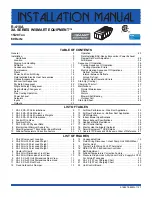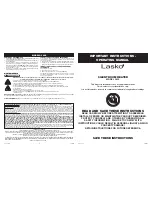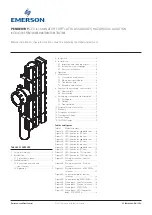
15
3. Insert pre-assembled pipe through the hole (2) from the out-
side and attach with 4 screws B 3.5 x 13 (7) together with the
filter (5) and the cowl disk (6).
The pipe is sealed by the provided rubber seal – no additional
sealing required.
Exhaust duct
The heater may only be used in combination with a roof cowl.
This must always be installed vertically or with a maximum in-
cline of 15 degrees! The enclosed installation components are
only designed for a roof incline of approximately 10°.
Only the Truma stainless steel exhaust pipe AE 3 (dia.55 mm)
must be used in combination with the provided Truma ÜR (dia.
65 mm) and ZR 80 air ducts for removing flue gas, since the
device has only been tested and approved with these pipes.
The flue gas pipe should preferably be routed along the
outside of the awning wall to the roof cowl. If space is re-
stricted the flue gas pipe can also be routed on the inside. To
do this, drill a dia. 70 mm opening in the upper area of the
heater box. The dia. 80 mm protecting tube (25) is then only
routed from the cowl (15) to the heater box.
Position roof cowl such that a
pipe can be routed from the
heater to the cowl that as-
cends along its entire length
(min. 1.5 m, max. 3 m!).
A minimum height of 1 m
must be reached with a pipe
that is 1.5 m in length. The
rest of the pipe routing to the
roof cowl must be almost
vertical.
Assembly of the roof cowl
Cut dia. 60 mm opening in a
central position approx.
55 mm from the side walls.
If the roof has a double layer,
line cavity (9) with wood to
stiffen roof so that it is not
deformed when the screws
are tightened and remains
watertight.
1. Slide O-ring (10), first angled leadthrough (11), moulded ring
(12), first sealing plate (13) and sealing ring (14) over the cowl
section (15) and insert through the roof from above. Slide the
second sealing plate (13) and the second angled leadthrough
(11) over the cowl section (15) from the inside and screw to-
gether using the threaded ring (16). Then secure the threaded
ring (16) using the screw (17).
2. Screw on the three provided cowl extensions (18) and the
cowl (19) from above.
The pipe is sealed by the provided rubber seals – no additional
sealing required.
60 mm
55
9
10
11
11
12
13
14
15
13
16
17
18
19
min 1,5 m / max 3 m
Exhaust pipe routing
The flue gas pipe must be securely and permanently
installed using several clamps in an unjointed piece and
be
ascending
along its entire length, since otherwise a water
pocket may form that will prevent the flue gas from exiting
freely.
1. Fit a connecting flange (22)
and a sealing ring (23) with
4 screws B 3.5 x 13 (24) from
the outside through the
dia. 70 mm hole (21).
2. Cut piece of outer dia.
80 mm protection tube (25)
that is long enough to reach
from the cowl connection (15)
to the connecting flange (22).
3. Slide a worm drive hose
clip (26) over the protection
tube (25).
4. Slide the dia. 65 mm ÜR air
duct (27) onto the dia. 55 mm
flue gas pipe (28) (must reach
from cowl to rear panel of
heater). Then slide the dia.
80 mm protection tube over
the dia. 65 mm ÜR air duct.
5. Insert the flue gas pipe (28)
into the cowl connection (15)
as far as it will go and secure
with a sheet metal screw (29).
Then slide the dia. 65 mm ÜR
air duct and the dia. 80 mm
protection tube over the cowl
connection and secure with a
screw (30).
6. Insert the flue gas pipe (28) with the dia. 65 mm ÜR air duct
(27) through the hole (21) towards the inside and secure the
protection tube (25) at the connecting flange (22) with the
clamp (26).
7. Attach the flue gas system to the outer wall using the three
provided ZRS clamps (31).
Condensate water drain
The provided hose (32 – length 40 cm) is used to remove the
condensate that is produced at the heater.
1. Drill a dia. 13 mm hole in the floor close to the connecting
piece (33).
2. Slide the condensate hose (32) firmly over the connecting
piece (33), cut off at an angle and insert the free end down-
wards through the hole (descending along its entire length).
Ø 13
32
33
25
22
15
26
27
28
29
30
31
25
28 27
Ø 70
24
22
23
21






































